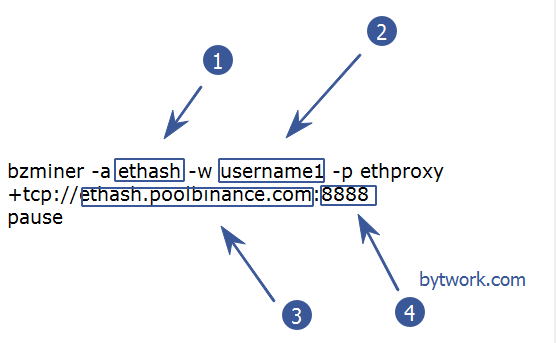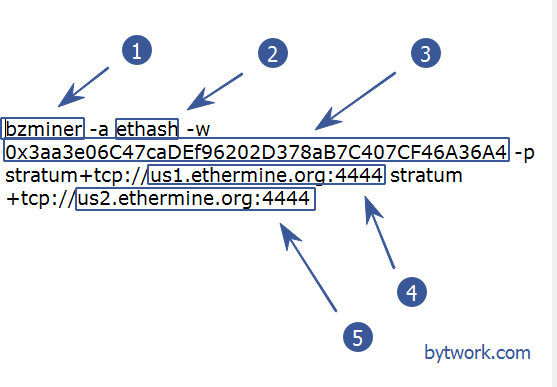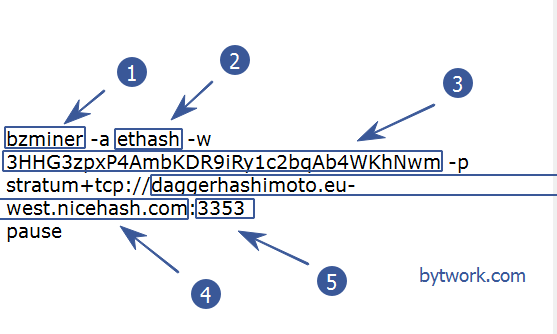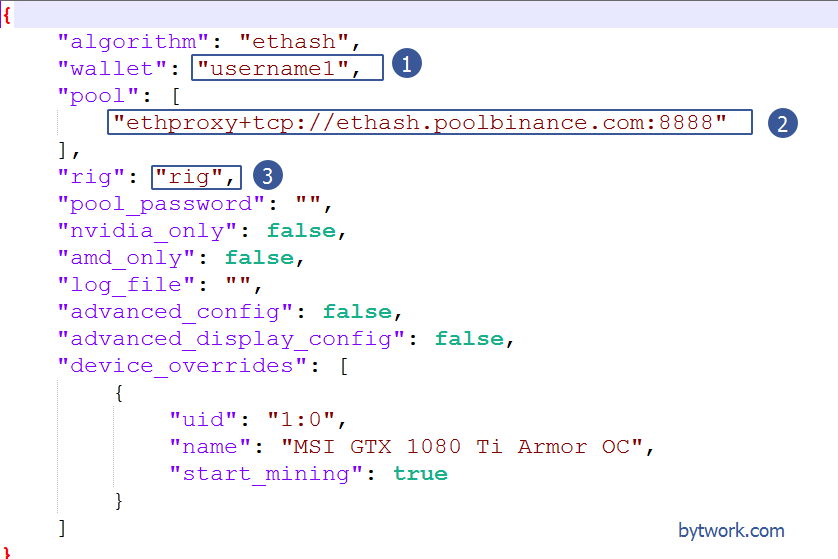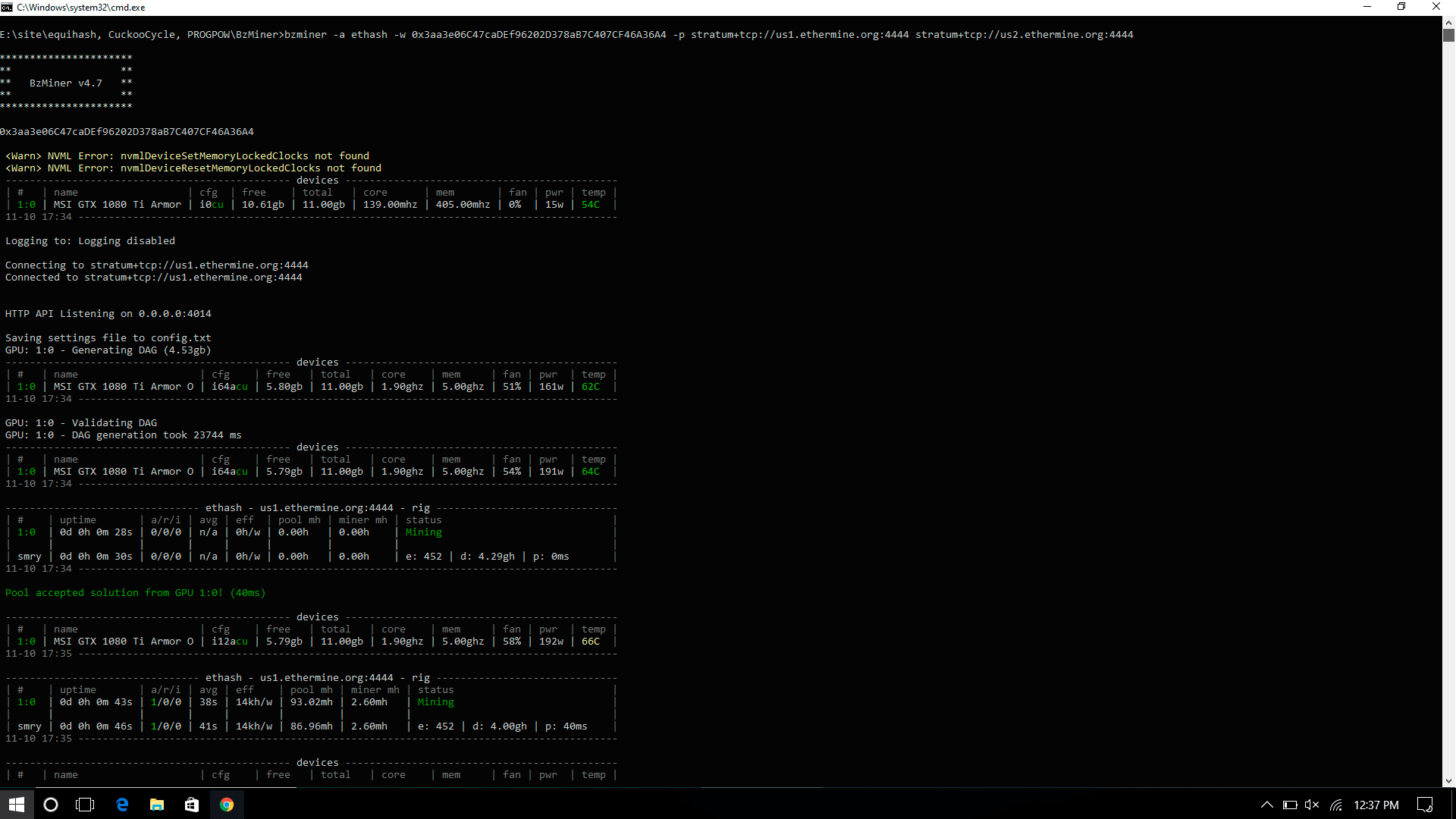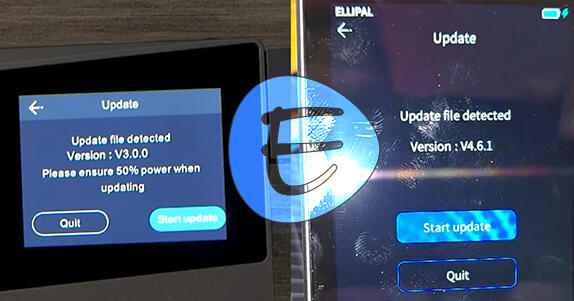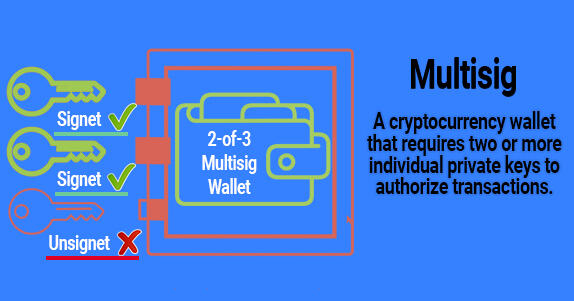BzMiner - download and configure
Rx 580: 28-30 Mh/s
Rx 570: 27-29 Mh/s
Rx vega: 41-43 Mh/s
BzMiner is a cryptocurrency miner that supports Ethash and Etchash hashing algorithms. The program has a low developer commission - 0.5%, a customizable display of information output, monitors the temperature of the video memory (only for windows). The software runs on Windows and Linux from a command line interface. At the same time, the graphical interface is accessible through a browser.
Advantages:
Easy to use miner;
HTTP API support;
Support for remote management of all farms on your network;
Possibility to control the pool / wallet on each device;
Auto-intensity dynamically adjusts graphics card workloads to reduce latency while maintaining a high hash rate.
Customization
To mine cryptocurrency using this miner, you need to set up .bat files (files with an extension .bat ) with the coins you want to mine. We will talk about this further.
Quickstart
- Step 1 - Download the archive with the program.
- Step 2 - Extract the contents of the archive to a convenient location
- Step 3 - Create Bat files or edit ready ones.
All cryptocurrencies are mined using a script file with permission .bat. This file can be edited with any text editor.
You can create the .bat file yourself. To do this, right-click in the program folder, then select "text document" and "change the resolution of this file" from .txt to .bat. Then you can right-click on it, click "edit" and enter the required commands.
We will present a properly configured batch file in this guide. One of our finished and properly configured files looks like this:
An example of setting up a batch file for Binance Pool (Ethereum)
ethash- enter the algorithm of the mined cryptocurrency. For Ethereum, this isethash. For Ethereum Classic, we would introduceetchash.username1- enter the account login from the Binance pool. This is the most important parameter. Don't forget to change the login to your own.ethash.poolbinance.com- enter the address of the pool (host).8888- enter the port number from the pool. This information can be found on the pool website.
Example:
bzminer -a ethash -w username1 -p stratum+tcp://ethash.poolbinance.com:8888
pausepause - a pause means that the miner will not close in case of problems, but will display an error message.
Please note that the syntax of the batch file must be correct. Extra punctuation marks, line breaks, spaces and other characters are not allowed here. Just copy the example above and change the login username1 to your login from the pool.
Let's consider other examples of configurations for different cryptocurrencies.
Example of setting up a batch file for Ethermine
bzminer- the name of the program being launched - we leave it as it is.-a ethash- cryptocurrency algorithm.0x3aa3e06C47caDEf96202D378aB7C407CF46A36A4- the address of the wallet to which the coins will be mined (replace this address with your address).us1.ethermine.org:4444- we specify the address and port from the main pool.us2.ethermine.org:4444- (optional) specify the address and port for the backup pool. In this example, we specified the Ethermine fallback address - us2.
The reserve pool option serves as a guarantee that mining will not be idle in the event that the first server is not available for some time. For example, due to overload or failure.
Example for Ethermine:
bzminer -a ethash -w 0x3aa3e06C47caDEf96202D378aB7C407CF46A36A4 -p stratum+tcp://us1.ethermine.org:4444 stratum+tcp://us2.ethermine.org:4444
NiceHash example
bminer- the name of the program.-a ethash- we indicate the algorithm.3HHG3zpxP4AmbKDR9iRy1c2bqAb4WKhNwm- enter the wallet address from the Nicehash program account. Replace this address with your own address. Only addresses from NiceHash account are allowed.daggerhashimoto.eu.nicehash.com:- we indicate the address of the Nicehash pool.3353- specify the port of the Nicehash pool.
Example:
bzminer -a ethash -w 3HHG3zpxP4AmbKDR9iRy1c2bqAb4WKhNwm -p stratum+tcp://daggerhashimoto.eu-west.nicehash.com:3353
pause
More examples
2miners (ETH):
bzminer -a ethash -w 0xBB942274AB3C8285400519e7F0c343Fca2394908 -p stratum+tcp://eth.2miners.com:2020
Flexpool:
bzminer.exe -a ethash -w 0x3aa3e06C47caDEf96202D378aB7C407CF46A36A4 -p ethstratum+tcp://eth.geodns.flexpool.io:4444
Nanopool:
bzminer -a ethash -w 0xBB942274AB3C8285400519e7F0c343Fca2394908 -p stratum+tcp://eth-eu2.nanopool.org:9999
Example for Ethereum Classic (Ethermine):
bzminer -a etchash -w 0x3aa3e06C47caDEf96202D378aB7C407CF46A36A4 -p stratum+tcp://us1-etc.ethermine.org:4444
Example for Ethereum Classic (Hiveon):
bzminer -a etchash -w 0x3aa3e06C47caDEf96202D378aB7C407CF46A36A4 -p stratum+tcp://na-etc.hiveon.net:8888
Configuration file
The program also supports mining through a configuration file - config.txt. It serves as an alternative to the .bat file.
To use config.txt , update the following options in the config file:
wallet: mining wallet;pool: Pool URL;rig: farm name (worker name) - needed to track statistics. You can specify any. For example MSI.
Then start bzminer directly or via the command line:
If you wish, you can specify the configuration file in the batch file for loading:
bzminer -c config.txt
Listing of the configuration file code:
{
"algorithm": "ethash",
"wallet": "3HHG3zpxP4AmbKDR9iRy1c2bqAb4WKhNwm",
"pool": [
"stratum+tcp://daggerhashimoto.eu-west.nicehash.com:3353"
],
"rig": "rig",
"pool_password": "",
"nvidia_only": false,
"amd_only": false,
"log_file": "",
"advanced_config": false,
"advanced_display_config": false,
"device_overrides": []
}
This completes the basic setup. By double-clicking the.bat file from the miner folder, you will start the process of mining cryptocurrency.
All command line arguments and parameters
Instead of options TEXT and INT you need to substitute an argument.
Options:
-h,--help Show help message.
-a TEXT Choose a mining algorithm. For example ethash.
-r TEXT Default farm name (worker/username). For example. 'MSI'.
--pool_password TEXT The default pool password.
--nvidia INT Mine only with Nvidia devices (0 = false, 1 = true).
--amd INT Mine only with AMD devices (0 = false, 1 = true).
-o TEXT If specified, console output will be written to this file.
-w TEXT Specify the wallet address.
-p TEXT.. An array of pool addresses. For example. stratum+tcp://us1.ethermine.org:4444 stratum+tcp://us2.ethermine.org:4444.
-v INT Set the verbosity level of the log. 0 = errors, 1 = warnings, 2 = information, 3 = debug, 4 = network.
-c TEXT The configuration file from which to load the settings. The default is config.txt.
-i INT Set the intensity of production (1 - 32). The higher, the more time the GPU spends on hashing. The default is 8.
-u INT Refresh rate in milliseconds. The default is 10000.
-g INT Overclock the miner as you see fit, rather than running it at full speed.
-b INT Pooled recovery period. 0 = disabled. A higher value means a longer time between recovery periods. the default is 0.
--nc INT Don't save information to the config file (but still read from it).
--cpu_validate INT Validate solutions on the CPU before submitting them to the pool.
--test INT Test the farm. Useful for tuning overclocking.
--http_enabled INT Enable or disable the HTTP API. 0 = disabled, 1 = enabled. Enabled by default.
--http_address TEXT Set the IP address of the HTTP API to listen to. By default 0.0.0.0.
--http_port INT Set which port the HTTP API is listening on. By default 4014.
--http_password TEXT Set a password for the HTTP API. If not set, the HTTP API will not be enabled. The default is empty.
--force_opencl INT Force all devices to use the OpenCL implementation (if possible).
--reset_oc_dag_gen INT Reset overclocking before generating the DAG file. Overclocking will be turned back on after creating the dag. 1 = enabled, 0 = disabled.
--devices Only register devices. Miner does not start.

